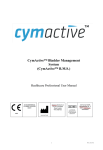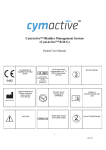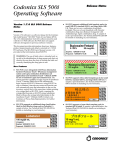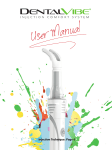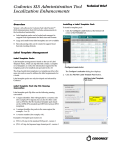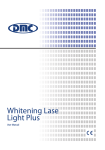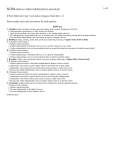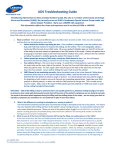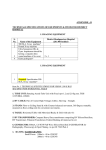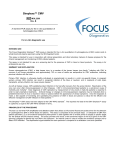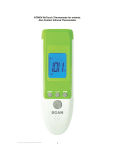Download our HCP IFU in PDF format
Transcript
CymActive™ Bladder Management System (CymActive™ B.M.S.) Healthcare Professional User Manual mdi Europa GmbH Langenhagener Str. 71 30855 Langenhagen Germany DO NOT REUSE Ingenion Medical Ltd 64 New Cavendish Street London W1G 8TB UK DO NOT USE IF PACKAGE IS DAMAGED CONSULT INSTRUCTIONS FOR USE CAUTION STERILISED USING ETHYLENE OXIDE DO NOT RESTERILISE CE MARKING & NUMBER NOTIFIED BODY AUTHORIZED REPRESENTATIVE IN THE EUROPEAN COMMUNITY 0482 MANUFACTURER 1 Rev.02 1. Indications Indications for Use of the CymActive™ Bladder Management System: (CymActive™ B.M.S.). The CymActive™ B.M.S. is indicated for use for urinary drainage in adult men who require a device to manage bladder drainage for urinary retention. Contents: 1. 1 CymActive™ Intra Urethral Catheter (CymActive™ I.U.C.) pre-assembled to CymActive™ Inserter. 2. 1 Healthcare Professional User Manual. 3. 1 Patient User Manual. Accessory (required but supplied separately): 1. The CymActive™ Actuator: • The CymActive™ Actuator is an accessory and is required and intended only for use with the CymActive™ Bladder Management System. • The correct handling is described in this instruction for use. • The CymActive™ Actuator is a reusable non-sterile device. Contacting materials: The patient contacting material of the indwelling CymActive™ I.U.C. is silicone. The patient contacting material of the single use CymActive™ Inserter is PVC. 2 Rev.02 2. Product Overview CymActive™ I.U.C. CymActive™ Inserter Figure 1: CymActive™ Intra Urethral Catheter (CymActive™ I.U.C.) preassembled to CymActive™ Inserter. Extraction Tethers Coudé Tip UroValve™ inserted into Valve Cavity Malecot Figure 2: CymActive™ Intra Urethra Catheter (CymActive™ I.U.C.) with UroValve™ Figure 3: CymActive™ Actuator (supplied separately) 3 Rev.02 Contraindications, Warnings, Precautions, and Possible Adverse Events 3. Contraindications A Patient must not have the CymActive™ Intra Urethral Catheter (CymActive™ I.U.C.) inside them when undergoing a magnetic resonance imaging (MRI) scan. A Patient who is required to maintain an empty bladder by constant free drainage should not use the CymActive™ I.U.C. A Patient with a medical implant that could be affected by exposure to a magnet, which includes any implanted electromechanical device that the magnet may interfere with, such as implanted pulse generators, should not use the CymActive™ I.U.C. If the patient is uncertain, this must be checked through medical records before inserting the CymActive™ I.U.C. Patients with documented history of sensitivity to silicone should not use the CymActive™ I.U.C. A Patient with an estimated length of the urethra (from bladder neck to halfway down the penile urethra) which is greater than 160mm should not use the CymActive™ I.U.C. 4 Rev.02 4. Warnings Patients who are mentally and/or physically incapable of operating the CymActive™ B.M.S. in accordance with the instructions for use and do not have access to a full-time companion or healthcare aide who is willing and able to assist the Patient with the physical tasks required by the Instructions for Use (e.g., actuation of the valve assembly using the actuator magnet) should not use the CymActive™ I.U.C. Patients who have current signs, symptoms and/or laboratory confirmation of urinary tract infection should seek appropriate treatment for the urinary tract infection. Patients who have a current diagnosis of bladder, symptomatic renal or uretheral calculus should not use the CymActive™ I.U.C. Patients with a history of bladder surgery within the past two months should not use the CymActive™ I.U.C. Patients with a history of prostatic or urethral surgery that has significantly affected the anatomy of the bladder neck and/or prostatic urethra should use the CymActive™ I.U.C. with care. The CymActive™ I.U.C. should be removed by a Healthcare Professional prior to the thirty-first (31st) day of use. The CymActive™ I.U.C. has not been adequately evaluated for use in patients who have a spinal cord injury. This device may not stay in the proper position in patients with spinal cord injury. A patient with urinary retention due to a spinal cord injury should only use the CymActive™ I.U.C. after discussing with their urologist. The device should only be used in a patient with spinal cord injury below T6 who has a good perianal reflex as determined by the physician. Patients with spinal cord injury and a documented history of autonomic dysreflexia should not use the CymActive™ I.U.C. The CymActive™ I.U.C. has not been studied in adolescents or children. Use in adolescents or children is not recommended. 5 Rev.02 5. Precautions A Healthcare Professional should examine packaging, verifying its integrity, to ensure sterility of the device has not been compromised. If packaging is damaged, do not use the CymActive™ I.U.C. The CymActive™ I.U.C. shall not be re-sterilized by the Healthcare Professional. A Healthcare Professional should not use excessive force to insert the CymActive™ I.U.C. Similar force should be used as when inserting an indwelling (Foley) catheter. Difficulty with insertion may indicate a blockage or anatomical irregularity that may inhibit the intended function and operation of the device and should be checked before further attempts at insertion of the CymActive™ I.U.C. A Healthcare Professional should only use water-soluble lubricants to aid insertion of the CymActive™ I.U.C. An urethoscopy may be performed by a healthcare professional prior to initial insertion to ensure anatomical regularity. An ultrasound scan may be performed by a healthcare professional after insertion to ensure the correct positioning of the CymActive™ I.U.C. Insertion and removal of the device is intended to be performed by healthcare professionals. The CymActive™ I.U.C. should be handled only under aseptic conditions. If Patient has been advised to use prophylactic antibiotics during invasive procedures, the healthcare professional will judge the potential risk of using the CymActive™ I.U.C. and judge the need for antibiotic prophylaxis on insertion. The CymActive™ I.U.C. should only be used by men who have adequate bladder capacity. The Healthcare Professional must review with the patient the instructions listed in 7.1 (16). If excessive urine leakage occurs after the patient has removed the CymActive™ Actuator to allow the UroValve™ to close, the patient should try to open and close the valve several times by moving the Actuator magnet under the shaft of the penis near the scrotum; moving the Actuator magnet slightly left, right, up, down, or in and out; and then removing the Actuator. 6 Rev.02 After several attempts, if excessive urine leakage continues, the patient should contact a physician in a timely manner. If reduced or no urine flows when the patient tries to empty his bladder, he should try to open and close the UroValve™ several times by moving the Actuator magnet under the shaft of the penis near the scrotum; moving the Actuator magnet slightly left, right, up, down, or in and out; and then removing the Actuator. After several attempts, if urine still does not flow or flows at a reduced rate, the patient should contact a physician immediately. The CymActive™ Actuator should be carried with the patient at all times. In case the patient has lost the CymActive™ Actuator please advise them to consult their Healthcare Professional or doctor immediately. 6. Possible Adverse Events Possible adverse events associated with the use of the CymActive™ Bladder Management System (CymActive™ B.M.S.) may include urinary tract infection, bacteriuria, trauma to the urethra or meatus, bleeding, stricture development, pain in the bladder, abdomen, or urethra, urine leakage, catheter or valve blockage, catheter migration, failure of the malecot to collapse fully upon removal, or failure of both tethers upon attempted removal. 7. Summary of Instructions for Use The CymActive™ Bladder Management System (CymActive™ B.M.S.). Instructions for Use for Healthcare Professionals. 7.1 Instructions for Insertion of the CymActive™ Intra Urethral Catheter (CymActive™ I.U.C.). Insertion and removal of the device is intended to be performed by a Healthcare Professional only. The Healthcare Professional is responsible for proper placement of the CymActive™ I.U.C. The CymActive™ I.U.C. should position the UroValve™ in the proximal penile urethra. An ultrasound scan may be performed by a healthcare professional after insertion to ensure the correct positioning of the CymActive™ I.U.C. 7 Rev.02 Note: If the estimated length of the urethra (from bladder neck to half-way down the penile urethra) is greater than 160 mm, the CymActiveTM I.U.C. should not be used. 1) Examine packaging to verify its integrity to ensure sterility of the CymActive™ I.U.C. has not been compromised. If packaging is damaged, do not use. Remove the CymActive™ I.U.C. preassembled to CymActive™ Inserter, from packaging after integrity of packaging is verified (See Figure 4). Figure 4: CymActive™ Intra Urethral Catheter (CymActive™ I.U.C.) preassembled to CymActive™ Inserter on Polycard Inserter Scale Clear Inserter Tube Clear Collar Female Handle Male Handle Locking Wire Handle Figure 5: CymActive™ Inserter 2) Slide the Male Handle forward (and engage the extended portion into the female handle) to collapse the Malecot. (see Figure 5) (Be careful not to rotate the Male Handle). Turn the Clear Collar to lock the Male Handle onto the Female Handle (see Figure 6) (Be careful not to rotate the Male Handle – Do not twist Clear Inserter Tube more than 45 degrees in either direction. Ensure that the Coudé Tip and the Vent both point up and are aligned.) 8 Rev.02 Vent Coudé Tip Male Handle Clear Collar Malecot Figure 6: CymActive™ I.U.C. and CymActive™ Inserter – handles mated 3) Verify that both the Coudé Tip and the Vent point up (See Figure 6) and that the Malecot is fully collapsed. If this is not the case, untwist the Clear Collar and separate the Male Handle from the Female Handle. Begin again, keeping the Coudé Tip and the Vent aligned. Do NOT rotate the Male Handle. 4) Lubricate the CymActive™ I.U.C. and Inserter with a water-soluble lubricant just prior to insertion. 5) The patient should be placed in the flex and abduct their knees position for easy insertion. 6) Insert the CymActive™ I.U.C. into the urethra. 7) Do not use excessive force to insert the CymActive™ I.U.C. The need for such force may indicate a blockage or anatomical irregularity that may inhibit the intended function and operation of the CymActive™ I.U.C. If this does occur, urethoscopy may be needed to assess urethral patency. 8) Correct placement will be confirmed by urine flow into the Clear Inserter Tube. 9) The Inserter Scale (See Figure 5) and urine visualization should indicate proper placement of the CymActive™ I.U.C. in the bladder. To insure that the Malecot is fully inserted into the bladder, continue inserting the device approximately 4-5 cm before expanding the Malecot. 9 Rev.02 10) To expand the Malecot: a. Unscrew the Clear Collar to unlock and remove it from the Female Handle (see Figure 7). Vent Coudé Tip Malecot Male Handle Clear Collar Figure 7: CymActive™ I.U.C. and CymActive™ Inserter – handles unlocked b. Pull the Male Handle back gently to expand the Malecot (see Figure 8). Inserter Scale Clear Inserter Tube Clear Collar Female Handle Male Handle Locking Wire Handle Figure 8: CymActive™ Inserter 11) Gently pull back on the Female Handle to position the Malecot at the bladder neck. You should feel some resistance to pulling. 12) Rotate and pull the protruding Locking Wire Handle back until the locking wire is fully removed (see Figure 9). Vent Pusher Tube Locking Wire Locking Wire Handle Figure 9: Removing Locking Wire 10 Rev.02 13) Completely remove the Pusher Tube by pulling back on the Male Handle (see Figure 10). Pusher Tube Figure 10: Removing Pusher Tube 14) Gently remove the Clear Inserter Tube leaving behind the properly placed CymActive™ I.U.C. 15) Proper placement can optionally be confirmed by using probe ultrasound (either trans-rectal ultrasound or trans-abdominal ultrasound). Only the Extraction Tethers may be visible, which can be trimmed to a desired length. 11 Rev.02 CymActive™ Actuator Figure 11: CymActive™ Actuator To confirm that the UroValve™ functions properly: Ask the Patient or healthcare assistant/caretaker to place the hand-held CymActive™ Actuator magnet directly in front of his scrotum, in order to open the UroValve™. Urine should flow out. Forcefully pressing the CymActive™ Actuator magnet against the body is not necessary to open the UroValve™, and may occlude the urethra. Ask the Patient or healthcare assistant/caretaker to move the hand-held CymActive™ Actuator magnet away from the Scrotum. Urine flow should stop. Care should be taken to ensure that each Patient is able to actuate the UroValve™ properly and without assistance (if companion or healthcare aide is not used) as shown by at least one successful demonstration prior to leaving the clinic. 16) The following instructions must be reviewed with the patient: a) Advise the Patient that the CymActive™ I.U.C. has not been adequately evaluated concerning sexual intercourse during the period the device is in the body and it is not known what effect sexual activity may have on the position or function of the CymActive™ I.U.C. b) Advise the Patient to actuate the CymActive™ I.U.C. at least every 4-6 hours or more often if he has the urge to do so. c) Advise the Patient to try to fully empty the bladder during each actuation. After urine flow stops, he should move the CymActive™ Actuator magnet 12 Rev.02 away and then place it back near the spot that opened the UroValve™ to see if he can pass more urine. d) Advise the Patient that he may initially experience a feeling of urgency, similar to what is described in the literature for indwelling catheters. The use of anticholinergic drugs might be suggested. e) Advise the Patient to keep the CymActive™ Actuator, even when shielded, away from objects affected by a magnetic field, such as credit cards, computer screens, etc. f) Advise the Patient that in the unlikely case of any adverse events the Patient should immediately consult the Healthcare Professional. g) Advise the Patient that the CymActive™ Actuator is required for use, but is supplied separately. h) Advise the Patient that the CymActive™ Actuator should be carried with the Patient at all times. In case the Patient has lost the CymActive™ Actuator he should consult his Healthcare Professional or doctor immediately. i) Advise the Patient not to pull on the tethers (if they extend below the meatus). 7.2 Instructions for Extraction To remove the CymActive™ I.U.C. the Healthcare Professional should grasp the two extraction tethers and gently pull. If the extraction tethers are internal to the meatus, the Healthcare Professional should grasp them with forceps under endoscopic vision and gently pull to remove the device. Alternatively, the extraction tethers or the UroValve™ can be grasped cystoscopically using grasping forceps. 13 Rev.02 © Ingenion Medical Limited 2014 14 Rev.02














